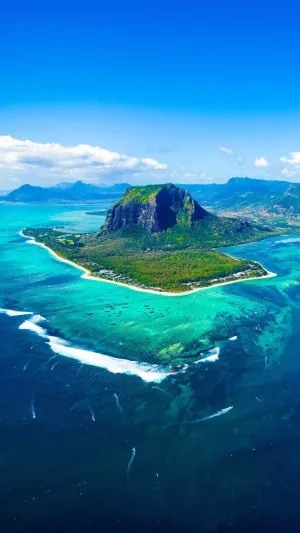The term "island" refers to a piece of land that is naturally surrounded by water and that remains above water at high tide, capable of supporting human habitation or economic activity.
The islands in the ocean vary in size, ranging from less than one square kilometer to hundreds or tens of thousands of square kilometers.
What natural processes led to the formation of these islands? Despite their varied appearances, there are certain patterns that can be observed. Islands are either separated from the mainland or created by underwater volcanic activity and the growth of coral polyps. There are four main types of islands: continental, volcanic, coral, and alluvial.
1. Continental Island
Continental Island is a large island connected to the mainland. It is formed for two reasons:
One factor that contributes to the formation of islands is crustal movement. When the middle part of a landmass sinks, it creates a strait, separating the originally connected land from the mainland and forming an island. Many of the world's largest islands such as Greenland, Irian, Kalimantan, and Madagascar, as well as well-known archipelagos like the Japanese archipelago, the British Isles, and the Malay Archipelago, were formed in this way.
The second type of island is formed by a moraine, which is a buildup of debris left behind by ancient glaciers. As the climate warmed and the glaciers melted, the sea level rose and the moraine piles were left above water, becoming islands. This is how the small islands off the coast of Norway, the Baltic Sea, and the eastern border of the United States and Canada were formed.
2. Volcanic Island
Subterranean volcanoes lurk beneath the surface of the sea and erupt year after year. Due to the low temperature at the bottom of the sea, the magma cools and condenses quickly, gradually piling up, and the pile becomes higher and higher. After thousands of years of accumulation, they finally emerge from the sea and form islands. This is how volcanic islands are formed, and the Hawaiian Islands in the Pacific Ocean are famous examples of volcanic islands.
3. Coral Island
Coral islands are islands built of coral polyps in the sea. Generally distributed in tropical oceans, it is a kind of island composed of living or dead coelenterate-coral reefs, so it is called a coral island. The surface of coral islands is often covered with a layer of ground coral powder--coral sand and coral mud.
4. Alluvial island
Alluvial islands are a special type of continental island, and they are also called sand islands because they are mainly composed of sand. Alluvial islands are sea land formed by land rivers carrying sediment to the sea and depositing it.
Rivers flow relatively fast on land, but when they reach the ocean, their speed slows down. This causes sediment to be deposited near the river mouth, and over time, it accumulates and forms a landmass above the water surface. This type of land is known as an alluvial island.
The world's largest alluvial island, Malajo Island, is the estuary island of the world's largest river, the Amazon River, with an area of 400,000 square kilometers and is listed as the 30th largest island in the world.
Apart from the four types of islands formed naturally, humans have also utilized modern science and technology to construct artificial islands. Although there are not many such islands and their area is relatively small, they hold significant economic importance and promising prospects.





